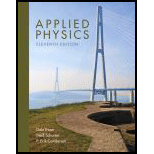
Applied Physics (11th Edition)
11th Edition
ISBN: 9780134159386
Author: Dale Ewen, Neill Schurter, Erik Gundersen
Publisher: PEARSON
expand_more
expand_more
format_list_bulleted
Concept explainers
Textbook Question
Chapter 6.1, Problem 15P
A 125-kg pile driver falls from a height of 10.0 m to hit a piling, (a) What is its speed as it hits the piling? (b) With what momentum does it hit the piling?
Expert Solution & Answer
Want to see the full answer?
Check out a sample textbook solution
Chapter 6 Solutions
Applied Physics (11th Edition)
Ch. 6.1 - Find the momentum of each object. 1. m = 2.00 kg, ...Ch. 6.1 - Find the momentum of each object. 2. m = 5.00 kg, ...Ch. 6.1 - Find the momentum of each object. 3. m = 17.0...Ch. 6.1 - Find the momentum of each object. 4. m = 38.0 kg, ...Ch. 6.1 - Find the momentum of each object. 5. m = 38 105...Ch. 6.1 - Find the momentum of each object. 6. m = 3.84 kg, ...Ch. 6.1 - Find the momentum of each object. 7. Fw = 1.50 ...Ch. 6.1 - Find the momentum of each object. 8. Fw = 3200 lb,...Ch. 6.1 - a. Find the momentum of a heavy automobile...Ch. 6.1 - a. Find the momentum of a bullet of mass 1.00 103...
Ch. 6.1 - a. Find the momentum of an automobile of mass 2630...Ch. 6.1 - A ball of mass 0.50 kg is thrown straight up at...Ch. 6.1 - A bullet with mass 60.0 g is fired with an initial...Ch. 6.1 - A cannon is mounted on a railroad car. The cannon...Ch. 6.1 - A 125-kg pile driver falls from a height of 10.0 m...Ch. 6.1 - A person is traveling 75.0 km/h in an automobile...Ch. 6.1 - A 75.0-g bullet is fired with a muzzle velocity of...Ch. 6.1 - A 40.0-grain bullet is fired at a muzzle velocity...Ch. 6.1 - a. What force is required to stop a 1250-kg car...Ch. 6.1 - (a) What force is required to slow a 1350-kg car...Ch. 6.1 - What force is required to stop a 3000-kg truck...Ch. 6.1 - What force is needed to stop a piece of heavy...Ch. 6.1 - A standard 5.0-oz baseball is thrown and reaches a...Ch. 6.2 - One ball of mass 0.500 kg traveling 6.00 m/s to...Ch. 6.2 - A ball of mass 625 g traveling 4.00 m/s to the...Ch. 6.2 - A 0.600-kg ball traveling 4.00 m/s to the right...Ch. 6.2 - A 90.0-g disk traveling 3.00 m/s to the right...Ch. 6.2 - A 98.0-kg parts cart with rubber bumpers rolling...Ch. 6.2 - A 75.0-kg paint cart with rubber bumpers is...Ch. 6.2 - A railroad car of mass 2.00 104 kg is traveling...Ch. 6.2 - Find the velocity of the railroad cars in Problem...Ch. 6.2 - One cart of mass 12.0 kg is moving 6.00 m/s to the...Ch. 6.2 - One cart of mass 15.0 kg is moving 5.00 m/s to the...Ch. 6.2 - A 1650-kg automobile moving south 12.0 m/s...Ch. 6.2 - A 16.0-g bullet is shot into a wooden block at...Ch. 6.2 - A 2450-kg automobile moving north 12.0 m/s...Ch. 6.3 - Two motorcycles of equal mass collide at a 90...Ch. 6.3 - Two pickup trucks crash at a 90 intersection. If...Ch. 6.3 - Two vehicles collide at a 90 intersection. If the...Ch. 6.3 - Two vehicles of equal mass collide at a 90...Ch. 6.3 - A vehicle with a mass of 1000kg is going east at a...Ch. 6.3 - Ball A with a mass of 0.500 kg is moving east at a...Ch. 6.3 - A vehicle with mass of 950kg is driving east with...Ch. 6.3 - A vehicle with a mass of 800kg is traveling west...Ch. 6 - Momentum is a equal to speed times weight b equal...Ch. 6 - Impulse is a. a force applied to an object b. the...Ch. 6 - Why do a slow-moving loaded truck and a speeding...Ch. 6 - How are impulse and change in momentum related?Ch. 6 - Why is follow-through important in hitting a...Ch. 6 - Describe in your own words the law of conservation...Ch. 6 - Describe conservation of momentum in terms of a...Ch. 6 - One billiard ball striking another is an example...Ch. 6 - One moving loaded railroad car striking and...Ch. 6 - A father and 8-year-old son are standing on ice...Ch. 6 - A truck with mass 1475 slugs travels 57.0 mi/h....Ch. 6 - A projectile with mass 27.0 kg is fired with a...Ch. 6 - A box is pushed with a force of 125 N for 2.00...Ch. 6 - What is the momentum of a bullet of mass 0.034 kg...Ch. 6 - A 4.00-g bullet is fired from a 4.50-kg gun with a...Ch. 6 - A 150-kg pile driver falls from a height of 7.5 m...Ch. 6 - A 15.0-g bullet is fired at a muzzle velocity of...Ch. 6 - What force is required to slow a 1250-kg car...Ch. 6 - One ball of mass 575 g traveling 3.50 m/s to the...Ch. 6 - A railroad car of mass 2.25 104 kg is traveling...Ch. 6 - A 195-g ball traveling 4.50 m/s to the right...Ch. 6 - Two trucks of equal mass collide at a 90...Ch. 6 - Ball A, of mass 0.35 kg, has a velocity 0.75 m/s...Ch. 6 - A coach knows it is vital that the volleyballs be...Ch. 6 - An automobile accident causes both the driver and...Ch. 6 - Several African tribes engage in a ritual much...Ch. 6 - Sally, who weighs 125 lb, knows that getting out...Ch. 6 - An automobile accident investigator needs to...
Additional Science Textbook Solutions
Find more solutions based on key concepts
If acceleration is proportional to the net force or is equal to net force.
Conceptual Physics (12th Edition)
Youre estimating costs for a new power line with your companys financial group. Engineering specifies a resista...
Essential University Physics (3rd Edition)
Which system (A–D) has the extrasolar planet that is easiest to detect from Earth? Explain your reasoning.
Lecture- Tutorials for Introductory Astronomy
Analyzing crystal diffraction is intimately tied to the various different geometries in which the atoms can be ...
Modern Physics
3. What is free-fall, and why does it make you weightless? Briefly describe why astronauts are weightless in th...
The Cosmic Perspective (8th Edition)
Explain all answers clearly, with complete sentences and proper essay structure if needed. An asterisk (*) desi...
Cosmic Perspective Fundamentals
Knowledge Booster
Learn more about
Need a deep-dive on the concept behind this application? Look no further. Learn more about this topic, physics and related others by exploring similar questions and additional content below.Similar questions
- Check Your Understanding There is a second solution to the system of equations solved in this example (because the energy equation is quadratic): v1.f=-2.5m/s , v2.f=0 . This solution is unacceptable on physical grounds; what’s with it?arrow_forwardAt the start of a basketball game, a referee tosses a basketball straight into the air by giving it some initial speed. After being given that speed, the ball reaches a maximum height of 4.25 m above where it started. Using conservation of energy, find a. the balls initial speed and b. the height of the ball when it has a speed of 2.5 m/s.arrow_forwardCalculate the kinetic energies of (a) a 2000.0-kg automobile moving at 100.0 km/h; (b) an 80.-kg runner sprinting at 10. m/s; and (c) a 9.11031 -kg electron moving at 2.0107m/s .arrow_forward
- If you hold this textbook out at shoulder height and let go, at the instant you let go, does the book have potential energy? Kinetic energy?arrow_forwardCheck Your Understanding Estimate the power expended by a weightlifter raising a 150-kg barbell 2 m in 3 s.arrow_forwardIn a common physics demonstration, a bowling ball is suspended from the ceiling by a rope. The professor pulls the ball away from its equilibrium position and holds it adjacent to his nose, as shown below. He releases the ball so that it swings directly away from him. Does he get struck by the ball on its return swing? What is he trying to show in this demonstration?arrow_forward
- Check Your Understanding (a) A car and a truck each moving with the same kinetic energy. Assume that the truck has more mass than the car. Which has the greater speed? (b) A car truck are each moving with same speed. Which has the greater kinetic energy?arrow_forwardAssume that the force of a bow on an arrow behaves like the spring force. In aiming the arrow, an archer pulls the bow back 50 cm and holds it in position with a force of 150 N. If the mass of the arrow is 50 g and the “spring” is massless, what is the speed of the arrow immediately after it leaves the bow?arrow_forwardA baseball of mass 0.25 kg is hit at home plate with a speed of 40 m/s. When it lands in a seat in the left-field bleachers a horizontal distance 120 m from home plate, it is moving at 30 m/s. If the ball lands 20 m above the spot where it was hit, how much work is done on it by air resistance?arrow_forward
- A 500-kg dragster accelerates from rest to a final speed of 110 m/s in 400 m (about a quarter of a mile) and encounters an average frictional force of 1200 N. What is its average power output in watts and horsepower if this takes 7.30s?arrow_forwardFind the kinetic energy of the stone in the preceding example when it has fallen 5.0 m.arrow_forwardCheck Your Understanding What potential energy U(x) can you substitute in Equation 8.13 that will result in motion with constant velocity of 2 m/s for a particle of mass 1 kg and mechanical energy 1 J?arrow_forward
arrow_back_ios
SEE MORE QUESTIONS
arrow_forward_ios
Recommended textbooks for you
 University Physics Volume 1PhysicsISBN:9781938168277Author:William Moebs, Samuel J. Ling, Jeff SannyPublisher:OpenStax - Rice University
University Physics Volume 1PhysicsISBN:9781938168277Author:William Moebs, Samuel J. Ling, Jeff SannyPublisher:OpenStax - Rice University
 Foundations of Astronomy (MindTap Course List)PhysicsISBN:9781337399920Author:Michael A. Seeds, Dana BackmanPublisher:Cengage Learning
Foundations of Astronomy (MindTap Course List)PhysicsISBN:9781337399920Author:Michael A. Seeds, Dana BackmanPublisher:Cengage Learning Stars and Galaxies (MindTap Course List)PhysicsISBN:9781337399944Author:Michael A. SeedsPublisher:Cengage Learning
Stars and Galaxies (MindTap Course List)PhysicsISBN:9781337399944Author:Michael A. SeedsPublisher:Cengage Learning Principles of Physics: A Calculus-Based TextPhysicsISBN:9781133104261Author:Raymond A. Serway, John W. JewettPublisher:Cengage Learning
Principles of Physics: A Calculus-Based TextPhysicsISBN:9781133104261Author:Raymond A. Serway, John W. JewettPublisher:Cengage Learning An Introduction to Physical SciencePhysicsISBN:9781305079137Author:James Shipman, Jerry D. Wilson, Charles A. Higgins, Omar TorresPublisher:Cengage Learning
An Introduction to Physical SciencePhysicsISBN:9781305079137Author:James Shipman, Jerry D. Wilson, Charles A. Higgins, Omar TorresPublisher:Cengage Learning

University Physics Volume 1
Physics
ISBN:9781938168277
Author:William Moebs, Samuel J. Ling, Jeff Sanny
Publisher:OpenStax - Rice University


Foundations of Astronomy (MindTap Course List)
Physics
ISBN:9781337399920
Author:Michael A. Seeds, Dana Backman
Publisher:Cengage Learning

Stars and Galaxies (MindTap Course List)
Physics
ISBN:9781337399944
Author:Michael A. Seeds
Publisher:Cengage Learning

Principles of Physics: A Calculus-Based Text
Physics
ISBN:9781133104261
Author:Raymond A. Serway, John W. Jewett
Publisher:Cengage Learning

An Introduction to Physical Science
Physics
ISBN:9781305079137
Author:James Shipman, Jerry D. Wilson, Charles A. Higgins, Omar Torres
Publisher:Cengage Learning
Work and Energy - Physics 101 / AP Physics 1 Review with Dianna Cowern; Author: Physics Girl;https://www.youtube.com/watch?v=rKwK06stPS8;License: Standard YouTube License, CC-BY